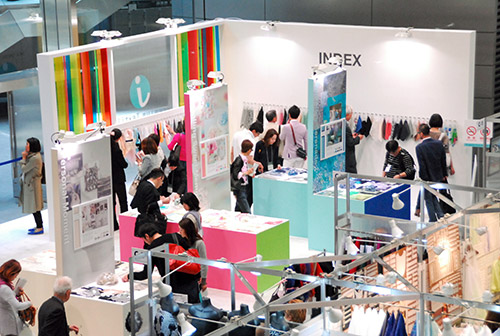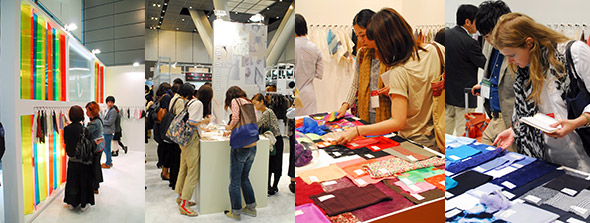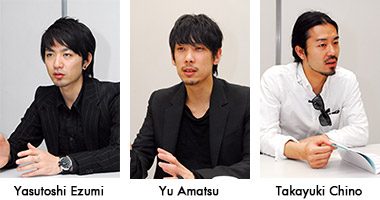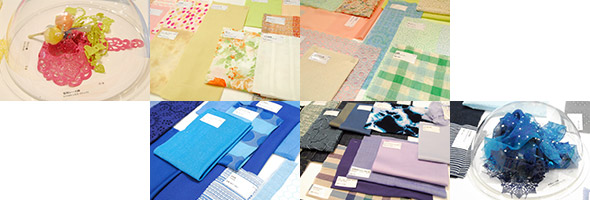![INDEX[1]Premium Textile Japan 2014 Spring/Summer Post show report - Part 1 -](images/title_index_01.gif) |
Our post-show report of the PTJ 2014 SS fair, held on May 8–9 at the Tokyo International Forum, will be distributed in two editions, Part 1 and 2. |
| |
・Exhibitors’ feedback - Recursion to domestic production / Hope for export
・Visitors’ feedback - Closer contacts and exchanges required for better creation |
| |
・Business matching programme
・Individual consultation on exporting for the PTJ exhibitors |

<Premium Textile Japan (PTJ) 2014 Spring/Summer>, organised by the Japan Fashion Week Organisation (JFW) was held on May 8 and 9 at the Tokyo International Forum / Exhibition Hall 2 (2000 sqm). In terms of scale, the exhibition hosted a total of 67 entries / 85.5 booth spaces (domestic exhibitors 60 / 77.5 booths, overseas exhibitors 7 / 8 booths). The proximity of the venue to Yurakucho, its general accessibility and the weaker yen which boosted domestic business fuelled enthusiastic and fruitful negotiations throughout the entire two-day fair. |
| < Dates > |
May. 8 - 9, 2013 (Wed.-Thu.) |
| < Venue > |
Tokyo International Forum, Exhibition Hall 2 |
| < Organiser > |
Japan Fashion Week Organization |
| < No. of exhibitors > |
67 companies /85.5 standard booths |
| |
(incl. overseas exhibitors: 7 companies /8 booths) |
| < No. of visitors > |
5,124 (Total) |
|

Recursion to domestic production alongside hope for exports.
- Exhibitors' feedback -
|
Affected by the depreciation of the yen with exchange rates at a level of JPY100 to the dollar, costs continue to soar for raw materials and energy such as electricity and/or raw petroleum, which worsens profitability for fabric makers and exacerbates the problem of how to pass on the increased cost.
This was reflected in many comments from exhibitors such as ‘Raw material costs keep on rising.’ ‘Costs are rising, not only for yarns but also other materials like dyes/dye aids’, and ‘Higher wages are required in some dyeing factories.’ Conversely, the fashion clothing market remains in a slump amid continuing deflation, compounding the difficulty of passing on increased costs to the actual selling prices.
However, the prospects are not all bleak, precisely because the weaker yen strengthens domestic competition against overseas products, enhancing expectations for exporting businesses. There is also a tendency to re-evaluate domestic products as the price difference subsides, since apparel or retail companies suffering from persistently unprofitable aggravation are forced to offer products with even greater value for money; a trend which boosts the overall price range. |

TAKASAWA TEXTILE MANUFACTURE CO., LTD. , which showcased stole items made of fine-count cashmere or silk yarns, commented ‘This time we saw many more visitors, reflecting increased interest in materials. I think there is an increasing tendency to recur to domestic production.’ According to TATSUMI WEAVING CO., LTD. ‘An acquaintance of mine received orders at the factory because some of his products cost less than those from China. It is true that the recent cost increase in raw materials is seriously affecting us, but the flow seems better when we look at the longer term. We get orders from overseas as well as domestic clients.’ strongly sensing change in the market flows.
WATANABE PILE TEXTILE CO., LTD. also stated that ‘This time we had buyers from Taiwan and Hong Kong and could successfully finalise a purchase agreement for 30,000 hand towels. They also wanted to source cut-and-sewn items so I introduced my acquaintance.’ who seemed to have sensed the potential for future business achievement. HATAOKA CO., which is actively cultivating the overseas market, added that ‘Thanks to the weaker yen, exporting has become favourable and we would like to take this chance by all means.’ MIYATA WF CO., LTD., whose premium items were acclaimed, said ‘The shift to domestic-made products is clear, and we anticipate further demand for Japan Quality in future.’ with considerable expectations.
To link this environmental change with solid business, fabric makers must strive further to develop products unique to Japan. Crescend Yonezawa developed and showcased stoles using extra-fine linen yarns, from Yamanashi prefecture as well as the Yonezawa region. ‘Although stoles are popular items, lower-priced competing products have emerged in the market, which is why we strive to develop elaborate stoles unique to Japan which cannot be found overseas.’ They showcased their products emphasising the difference of ‘Made in Japan ‘ creation such as stoles made using linen delicately embroidered with fine motifs alongside yarn-dyed stoles in borders, first leno-woven with silk and silk-linen, then water-washed to transform the borders into wavy lines. |

Close contacts and exchanges - the key to better creation -
- Visitors' feedback - |
 |
Designer Yasutoshi Ezumi (Yasutoshi Ezumi) visits the fair on each occasion to source fabrics.‘Since this fair is a total textile fair, a wide range of fabrics are available in terms of variation compared with individual fabric fairs/salons, which adds significant value to the fair. I usually look for fabrics online or at the index corner, but when I have more concrete ideas for creation, for example, if I want to source lace or jacquard in particular, I go for booths with those items. Compared with previous fairs, the minimum quantity (batch) was set to 1 roll instead of 2-3. We appreciate that, since we start by making samples for which only a small quantity is required, on the basis of orders received. I see more makers who understand this business situation.’ he commented. It seems that efforts to deal with factories to cope with a small scale are being reinforced with each fair.‘OMI ORIMONO Co., Ltd. is one of them. Their jacquard textiles are fantastic. I publicise the fact that I use their fabrics in my show, since they always listen to my specific (small-scale) requests when I order. I also use Italian knit yarns, but Japanese fabrics are very varied and the scope of Japan-made items covers most of what is found in the world. This is proof of profound technicity. Each season is a struggle for us as designers - win or lose. There are tough questions posed each season as to whether my clothing will sell well at shops. To clarify things, ideas and thoughts must be exchanged with textile makers, giving detailed and specific plans for the kind of clothes they have in mind. I do believe that closer contacts and detailed exchanges between mid- and downstream sectors would be key to development for the future Japanese fashion industry.’ he explained. |
Designer Yu Amatsu, (A DEGREE FAHRENHEIT) also comes to source his fabrics at the PTJ.‘What I seek varies according to the theme each time, so I am constantly checking fabrics. As for designers, the unit of the lot (batch) is more important than price. When I survey the fair venue, some booths make me feel like entering as they clearly showcase what they want to promote and thus arouse my curiosity.’ |
Designer Takayuki Chino, (bethourire) came to the fair to source thin/light yet taut fabrics. ‘I sense the kind of makers or what they showcase when I see how they present their products.’ seemingly reflecting the importance of product presentation. |

|
![INDEX[2] Upcoming schedule for fiscal year 2013](images/title_index_02.gif)
|
Intertextile Shanghai Apparel Fabrics
Japan Pavilion 2013 |
| < Dates > |
: |
Oct. 21 - 24, 2013 (Won.-Thu.) |
| < Venue > |
: |
Shanghai New International Expo Center |
| Premium Textile Japan 2014 Autumn/Winter |
| < Dates > |
: |
Nov. 20 - 21, 2013 (Wed.-Thu.) |
| < Venue > |
: |
Tokyo International Forum, Exhibition Hall 2 |
| < Dates > |
: |
Nov. 20 - 21, 2013 (Wed.-Thu.) |
| < Venue > |
: |
Tokyo International Forum, Exhibition Hall 1 |
|
|
|
|
|
This e-mail magazine is sent to all individuals having visited our show, JFW-Japan Creation in the past and/or who have registered for an e-mail magazine subscription on the website as well as to all members concerned.
Please refrain from replying to this e-mail address as it is used for delivering messages only.
If you would like to modify your address or unsubscribe, please contact the following: |
|
 |
|

